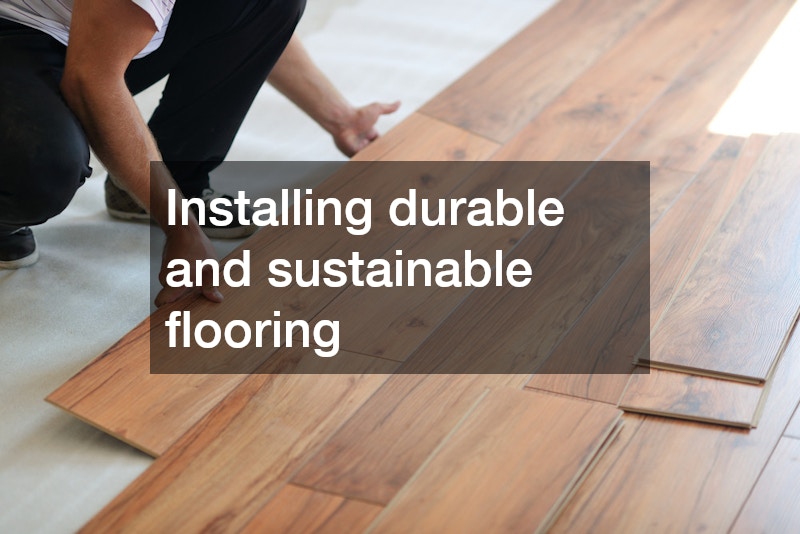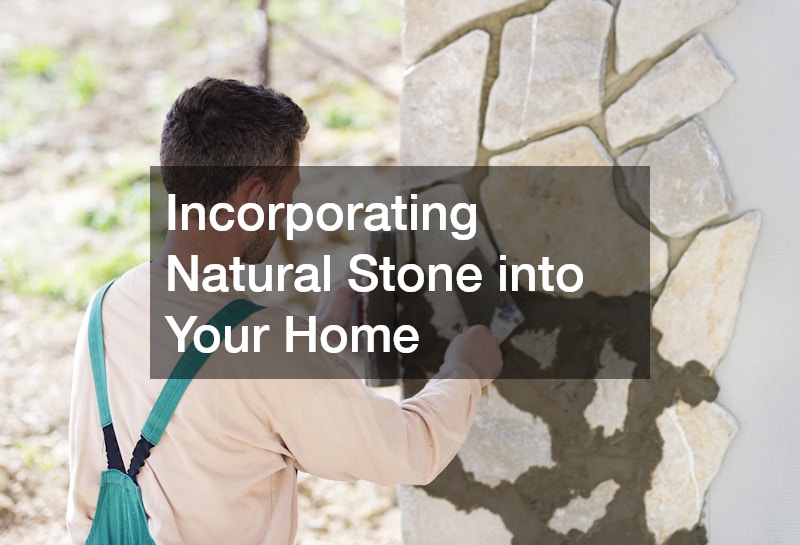More homeowners are looking for ways to make their homes eco-friendly as awareness of environmental issues increases. Green home design is not only good for the environment, but it also makes for healthier living conditions and can save you money over time. Integrating natural elements in your home’s design is key to achieving sustainability. Every choice, from building materials to finishings, can have an impact. This guide explores ways to incorporate eco-friendly practices into your home design. It focuses on decks and doors, flooring and cabinets, barns and countertops, as well as stone, wood, fencing, and pools.
Building a Sustainable Outdoor Deck
A deck is one of the best ways for you to enjoy your outdoor space. A traditional deck, however, can have an environmental impact. You can create an eco-friendly outdoor area by working with deck builders who specialize in sustainable practices.
Choose Eco-Friendly Material
Selecting the right materials is the first step to building a deck that’s sustainable. Consider options such as wood sourced sustainably, composite materials made of recycled plastics, or even reclaimed timber. These materials help reduce your carbon footprint and demand for virgin resources.
Design Considerations
Well-designed decks can make the most of natural lighting and ventilation. This will reduce your need for artificial cooling and lighting. You can create natural shade by incorporating pergolas and trellises that have climbing plants. Position your deck so that it is in line with the sun, and you can enjoy a warm environment in cooler months while enjoying shade in hotter months.
Work with Professionals
Custom deck builders are able to provide valuable insight into the design and materials that can be used for a sustainable deck. They can suggest the best eco-friendly construction methods and materials to make your deck beautiful while being kind to the planet.
Enhancing Entrances with Sustainable Wood Doors
The front door is what guests first see, and it sets the tone of your home’s style. Sustainable wood doors are a great way to be environmentally friendly and make a statement.
Material Selection
Choose custom wood doors that are made of reclaimed or FSC-certified wood. Reclaimed wood has a unique, weathered appearance that gives your home character and history. FSC-certified lumber is made from forests that are managed responsibly and provide economic, environmental, and social benefits.
Eco-Friendly Finishes
The finish that you choose for wood doors will have a major impact on the environmental friendliness of your door. Water-based, non-toxic finishes protect wood without releasing harmful volatile organic compounds (VOCs) into the atmosphere. These finishes are safer for your health as well as the environment.
Craftsmanship & Durability
By investing in quality craftsmanship, you can ensure that your custom-made wood doors are durable and long-lasting. This will reduce the need to replace them. It is not only environmentally friendly, but it also preserves the beauty of your home.
Installing Durable and Sustainable Flooring

The flooring in your home is an important part of the design. Choosing sustainable options will reduce your impact on the environment. Oak flooring is popular for its timeless beauty and durability.
Oak Trees: Benefits and Uses
It is a hardwood with excellent durability. The natural color variations and grain add warmth to any room. Oak’s durability allows for less frequent replacements and a reduction in resources.
Sustainable Sourcing
If you are looking for oak flooring, make sure that the supplier practices responsible forestry. You can look for certifications like FSC (Program for the Endorsement of Forest Certification) or PEFC to ensure that the wood has been harvested sustainably.
Maintenance Tips
Use eco-friendly products to maintain your oak flooring. They should not contain harsh chemicals. Your floors will look beautiful and have a minimal impact on the environment if you regularly clean them with a wet mop.
Custom Cabinets Created with a Green Approach
Custom cabinets can enhance the aesthetics and functionality of your home. Without sustainable practices, custom cabinets can unintentionally contribute to environmental degradation. You can reduce their environmental impact by choosing cabinets made from FSC-certified or reclaimed materials. By avoiding harmful chemicals, these choices promote healthier indoor air and conserve natural resources. Custom cabinets made sustainably will ensure that the interior of your home remains beautiful and environmentally friendly for many years.
Eco-Friendly Materials
Hire a cabinet maker that uses reclaimed bamboo or wood. Reclaimed wood is a great way to reduce the need for new lumber, and it gives old materials a new lease of life. Bamboo is a renewable resource that grows rapidly and uses less pesticides and fertilizers than hardwoods.
Sustainability Practices
Make sure that the production process is waste-free and utilizes non-toxic finishes and adhesives. Cabinets made from formaldehyde-free plywood and low VOC paints and stains are ideal. These options improve the indoor air quality and lower your exposure to harmful chemical substances.
Design for Longevity
It is important to build and design custom cabinets that will last. Quality craftsmanship and timeless designs ensure that you won’t have to replace your cabinets as often, saving resources and reducing waste.
Build a Sustainable Barn
A barn is a valuable and versatile addition to any property. It can be used for storage, as a workshop, or even as an additional living area. A sustainable barn is beneficial to both you and the planet.
Green Building Techniques
Hire barn builders that use sustainable materials and construction methods. Reclaimed wood, recycled roofing materials, and energy-efficient windows and doors are all examples. These materials are environmentally friendly and increase the durability of the barn.
Multi-Functional Design
Design your barn so that it can serve multiple functions, maximizing its utility and sustainability. A barn, for example, can be used as a workspace or to accommodate guests. This flexibility allows for the most efficient use of space and reduces the requirement for additional structures.
Energy Efficiency
Include energy-efficient features like solar panels, natural ventilation, and insulation made of recycled materials. These features can reduce the energy consumption of the barn and even make it energy-neutral or positive.
Choose Eco-Friendly Countertops
Countertops play a key role in the design and functionality of both kitchens and baths. By choosing eco-friendly countertops, you can not only enhance the beauty of them but also reduce your carbon footprint. Sustainability choices such as recycled glass, bamboo granite, or quartz responsibly sourced offer durability, aesthetic appeal, and an environmental commitment. Eco-friendly countertops can be used to create beautiful, functional surfaces that reflect your values and help contribute to a healthy planet.
Material Options
Granite countertops are popular because of their durability and natural beauty. Choose granite from suppliers that prioritize sustainable quarrying. It ensures the stone is mined in a manner that respects local ecosystems and minimizes environmental damage.
Installation and Maintenance
Precision and care are required when installing granite countertops. Use low-VOC sealants and adhesives. Maintaining your countertops with eco-friendly products is the best way to keep them looking great and protect the environment.
Complementary Elements
Combining granite with natural materials such as wood and stone will create an eco-friendly, cohesive design. Combining granite countertops with reclaimed wooden cabinets and natural stone backsplashes can create a sustainable and harmonious kitchen.
Incorporating Natural Stone into Your Home

Natural stone is a timeless material that will add beauty to your home and provide exceptional durability. It is a great choice for countertops, flooring, or walls. The unique colors and textures of natural stone add an air of permanence and elegance, and its durability reduces the need to replace it frequently, saving resources. Natural stone, when responsibly sourced, supports eco-friendly and sustainable practices.
Choose Sustainable Stone
Join forces with a supplier of natural stone who sources responsibly. It includes practices like minimizing the impact of quarrying, restoring quarries, and ensuring fair labor practices. Suppliers of sustainable stone often offer certification and documentation to support their practices.
Applications
You can use natural stone in many different parts of your house. Stone flooring is durable and easy to maintain. Stone backsplashes and walls add visual interest and texture. Stone pathways and patios can create a seamless transition from your garden to home.
Natural Stone: Benefits and Uses
Natural stone is extremely durable and reduces the need to replace it. The stone is hypoallergenic and, therefore, a good choice for allergy sufferers. Stone has excellent thermal properties that help regulate indoor temperature and reduce energy usage.
Designing a Natural Swimming Pool
Natural swimming pools are an environmentally friendly and stunning alternative to chlorinated pools. These pools use natural filtration and aquatic plants to provide a swimming experience free of chemicals that is both healthier for your family and the environment. Natural swimming pools blend seamlessly with the landscape to create a beautiful and inviting oasis. They also promote sustainability. This innovative pool design provides a chemical-free, clean, and clear water experience.
Natural Pool Benefits
Plants and biological filters are used to filter the water in natural pools, eliminating the use of chlorine and other chemicals. It creates a safer swimming environment, and it reduces the environmental impact.
Hire Professionals
Work with pool contractors in your area who are experts at natural pool design. They can assist you in choosing the correct plants and filtration system to keep your swimming pool clear and clean.
Integrating with the Landscape
Your natural pool should blend in seamlessly with the landscape. Natural materials such as wood and stone can be used to create an outdoor space that is harmonious. Add features such as waterfalls and natural landscaping to your pool area to enhance its beauty and sustainability.
Conclusion
Integrating natural elements in your home design can be a great way to promote sustainability and create a healthier environment. Each choice, from eco-friendly doors and decks to sustainable countertops and flooring, contributes to making a home greener. Working with professionals you trust and prioritizing sustainability practices will ensure that your home is beautiful and environmentally friendly.
A proactive approach to sustainable design can not only benefit the environment but can also improve your quality of living. Sustainability materials are more durable and healthier and provide long-term value. Eco-friendly design principles can transform your home into a place that reflects the commitment you have for the planet and future generations.
